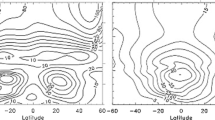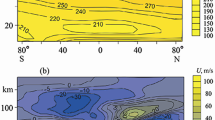Abstract
The mesosphere, which extends from about 50 to 90 km altitude, is an atmospheric region characterized by a negative gradient of solar energy absorption, and thus, temperature. Although the distribution of most minor constituents is dominated by photochemistry, vertical transport does have a pronounced effect on many of them. Hence, we discuss the basic dynamic principles and their application to the important mesopheric motions: acoustic-gravity waves, tides, planetary scale waves, and eddy motions.
The most important minor electrically neutral constituents are compounds of oxygen, hydrogen and nitrogen. In fact, the allotropes of oxygen are in many ways the most significant because they screen out solar ultraviolet radiation and provide the principal source of mesospheric heating (absorption of solar UV by O2 and ozone). We also discuss oxides of nitrogen and hydrogen which strongly influence the balance of odd oxygen (O and O3). Brief discussions of the chemistry of carbon compounds and of excited species are also included.
The chemistry of ionic species present in the mesosphere is very important because it strongly influences the propagationand absorption of radio waves. Because of ion clustering and negative-ion formation, such chemistry is extremely complex, and it is only very recently that we have begun to understand it. The current state of knowledge is discussed in some detail. The principles involved in constructing models for predicting the distribution of minor constituents, both neutral and ionic, are presented.
Similar content being viewed by others
References
Ackerman, M. and Simon, P.: 1973, ‘Rocket Measurements of Solar Fluxes at 1216 Å, 1450 Å and 1710 Å,’Solar Phys. 30, 345.
Anderson, J. G.: 1971, ‘Rocket Measurement of OH in the Mesosphere’,J. Geophys. Res. 76, 7820.
Arnold, F., Kissel, J., Krankowsky, D., Weider, H., and Zahringer, J.: 1971, ‘Negative Ions in the Lower Ionosphere: A Mass Spectrometer Measurement’,J. Atmospheric Terrest. Phys. 33, 1169.
Banks, P. M. and Kockarts, G.: 1973,Aeronomy, vol. A, Academic Press, New York and London, p. 172.
Barth, C. A.: 1966, ‘Rocket Measurement of Nitric Oxide in the Upper Atmosphere’,Planetary Space Sci. 14, 623.
Blamont, J. E. and Vidal-Madjar, A.: 1971, ‘Monitoring of the Lyman Alpha Emission Line of the Sun During the Year 1969’,J. Geophys. Res. 76, 4311.
Chapman, S. and Lindzen, R. S.: 1970,Atmospheric Tides, D. Reidel, Dordrecht, p. 200.
Chubb, T. A., Friedman, H., and Kreplin, R. W.: 1960, ‘Measurements Made of High Energy X-rays Accompanying Three Class 2+ Solar Flares’,J. Geophys. Res. 65, 1831.
Detweiler, C. R., Garrett, D. L., Purcell, J. D., and Tousey, R.: 1961, ‘The Intensity Distribution in the Ultraviolet Solar Spectrum’,Ann. Geophys. 17, 263.
Dickinson, R. E.: 1973, ‘Method of Parameterization of Infrared Cooling between 30 and 70 km’,J. Geophys. Res. 78, 4451.
Dubach J. and Barker, W. A.: 1971, ‘Charged Particle Induced Ionization Rates in Planetary Atmospheres’,J. Atmospheric Terrest. Phys. 33, 1287.
Fehsenfeld, F. C. and Ferguson, E. E.: 1974, ‘Laboratory Studies of Negative Ion Reactions with Atmospheric Trace Constituents’,J. Chem. Phys. 61, 3181.
Hall, L. A., Damon, K. R., and Hinteregger, H. E.: 1963, ‘Solar Extreme Ultraviolet Photon Flux Measurements in the Upper Atmosphere of August 1961’, in W. Priester (ed.),Space Research III, North-Holland, Amsterdam, p. 745.
Hunt, B. G.: 1966, ‘Photochemistry of Ozone in a Moist Atmosphere’,J. Geophys. Res. 71, 1385.
Hunt, B. G., 1973, ‘A Generalized Aeronomic Model of the Mesosphere and Lower Thermosphere Including Ionospheric Processes’,J. Atmospheric Terrest. Phys. 35, 1755.
Justus, C. G. and Woodrum, A.: 1973, ‘Upper Atmospheric Planetary-Wave and Gravity-Wave Observations’,J. Atmospheric Sci. 30, 1267.
Kirchoff, V. W. J. H. and Clemesha, B. R.: 1973, ‘Atmospheric Sodium Measurements at 23°S’,J. Atmospheric Terrest. Phys. 34, 1493.
Lindzen, R. S.: 1970, ‘Internal Gravity Waves in Atmospheres with Realistic Dissipation and Temperature. Part I. Mathematical Development and Propagation of Waves into the Thermosphere’,Geophys. Fluid Dyn. 1, 303.
Llewellyn, E. G., Evans, W. F. J., and Wood, H. C.: 1973, ‘O2(2Δ) in the Atmosphere’, in B. M. McCormac (ed.),Physics and Chemistry of the Upper Atmosphere, D. Reidel, Dordrecht, p. 193.
Meira, L. G.: 1971, ‘Rocket Measurements of Upper Atmospheric Nitric Oxide and Their Consequences to the Lower Ionosphere’,J. Geophys. Res. 76, 202.
Nagata, T., Tohmatsu, T., and Ogawa T.: 1971, ‘Sounding Rocket Measurement of Atmospheric Ozone Density, 1965–1970’, in K. Ya. Kondratyev, M. J. Rycroft, and C. Sagan (eds.),Space Research XI, Akademie-Verlag, Berlin, p. 849.
Narcisi, R. S.: 1973, ‘Mass Spectrometric Measurements in the Ionosphere’, in B. M. McCormac (ed.),Physics and Chemistry of the Upper Atmosphere, D. Reidel, Dordrecht, p. 171.
Narcisi, R. S. and Bailey, A. D.: 1965, ‘Mass Spectrometric Measurements of Positive Ions at Altitudes from 64–112 km’,J. Geophys. Res. 70, 3687.
Narcisi, R. S., Bailey, A. D., Dell Luca, L., Sherman, C., and Thomas, D. M.: 1971, ‘Mass Spectrometric Measurements of Negative Ions in the D- and Lower E-Regions’,J. Atmospheric Terrest. Phys. 33 1147.
O'Brien, K.: 1970, ‘Calculated Cosmic Ray Ionization in the Lower Atmosphere’,J. Geophys. Res. 75, 4357.
Pearce, J. B.: 1969, ‘Rocket Measurements of Nitric Oxide between 60 and 96 km’,J. Geophys. Res. 74, 853.
Ratcliffe, J. A.: 1971, ‘William Henry Eccles’,Biographical Memoirs of Fellows of the Royal Society 17 (Nov.), Royal Society, London, p. 195.
Ratcliffe, J. A.: 1972, ‘The Formation of the Ionosphere. Ideas of the Early Years (1925–1955)’,Geofyiske Publ. 29, 13.
Reid, G. C.: 1971, ‘The Roles of Water Vapor and Nitric Oxide in Determining Electron Densities in the D-region’ in G. Fiocco (ed.)Mesospheric Models and Related Experiments D. Reidel, Dordrecht. p. 198.
Scholz, T. G., Ehhalt, D. H., Heidt, L. E., and Martell, E. A.: 1970, ‘Water Vapor, Molecular Hydrogen, Methane, and Tritium Concentrations near the Stratopause’,J. Geophys. Res. 75, 3049.
Shimazaki, T.: 1967, ‘Dynamic Effects on Atomic and Molecular Oxygen Density Distributions in the Upper Atmosphere; a Numerical Solution to Equations of Motion and Continuity’,J. Atmospheric Terrest. Phys. 29, 723.
Shimazaki, T. and Laird, A. R.: 1970, A Model Calculation of the Diurnal Variation in Minor Neutral Constituents in the Mesosphere and Lower Thermosphere Including Transport Effects’,J. Geophys. Res. 75, 3221; correction, 1972,J. Geophys. Res. 77, 276.
Smith, E. V. P. and Gottlieb, D. M.: 1974, ‘Solar Flux and Its Variations’,Space Sci. Rev. 16, 771.
Strobel, D. F.: 1971, ‘Odd Nitrogen in the Mesosphere’,J. Geophys. Res. 76, 8384.
Swider, W. and Narcisi, R. S.: 1975, ‘A Study of Nighttime D-Region During a PCA Event’,J. Geophys. Res. 80, 655.
Thomas, L., Gondhalekar, P. M., and Bowman, M. R.: 1973, ‘The Negative Ion Composition of the Daytime D-region’,J. Atmospheric Terrest. Phys. 35, 397.
Tisone, G. C.: 1973, ‘Measurements of NO Densities During Sunrise at Kauai’,J. Geophys. Res. 78, 746.
Turco, R. P.: 1975, ‘Photodissociation Rates in the Atmosphere below 100 km’,Geophys. Surveys 2, 153.
Velinov, P.: 1968, ‘Ionization in the Ionospheric D-region by Galactic and Solar Cosmic Rays’,J. Atmospheric Terrest. Phys. 30, 1891.
Webber, W. R.: 1962, ‘The Production of Free Electrons in the Ionospheric D-Layer by Solar and Galactic Cosmic Rays and the Resultant Absorption of Radio Waves’,J. Geophys. Res. 67, 5091.
Whitten, R. C. and Poppoff, I. G.: 1965,Physics of the Lower Ionosphere, Prentice-Hall, Englewood Cliffs, N. J., pp. 136–138.
Whitten, R. C. and Poppoff, I. G.: 1971,Fundamentals of Aeronomy, John Wiley and Sons, New York, pp. 162–165, pp. 245–252.
Whitten, R. C., Sims, J. S., and Turco, R. P.: 1973, ‘A model of Carbon Compounds in the Stratosphere and Mesosphere’,J. Geophys. Res. 78, 5362.
Whitten, R. C. and Turco, R. P.: 1974, Perturbation of the Stratosphere and Mesosphere by Aerospace Vehicles’,AIAA J. 12, 1110.
Author information
Authors and Affiliations
Rights and permissions
About this article
Cite this article
Poppoff, I.G., Whitten, R.C. The mesosphere. Geophysical Surveys 2, 399–429 (1976). https://doi.org/10.1007/BF01454193
Issue Date:
DOI: https://doi.org/10.1007/BF01454193




